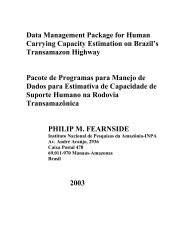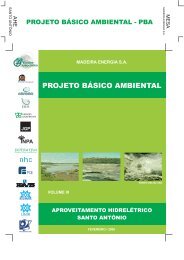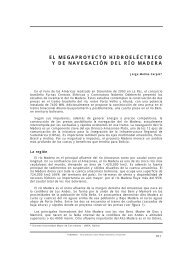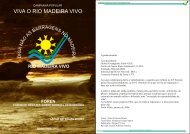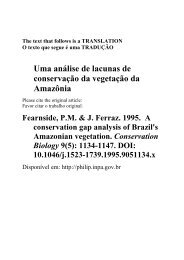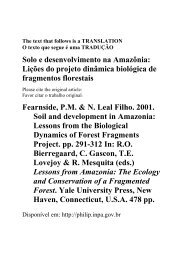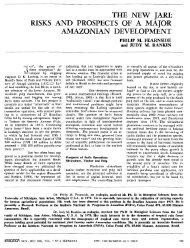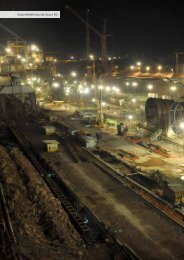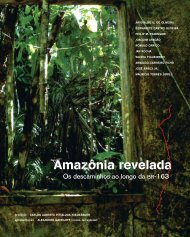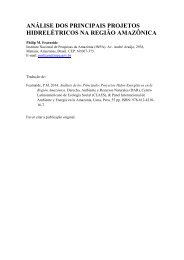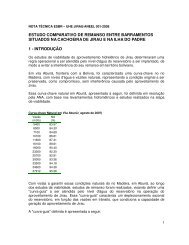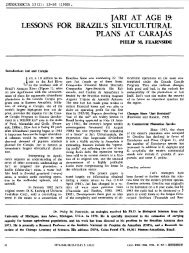THE FUTURE OF THE AMAZON - Philip M. Fearnside - Inpa
THE FUTURE OF THE AMAZON - Philip M. Fearnside - Inpa
THE FUTURE OF THE AMAZON - Philip M. Fearnside - Inpa
You also want an ePaper? Increase the reach of your titles
YUMPU automatically turns print PDFs into web optimized ePapers that Google loves.
9the next two decades. We confine our predictions to the Brazilian Legal Amazon,which comprises about two-thirds of the basin (ca. 4.9 million km 2 ), because accuratespatial data on deforestation, transportation networks, and planned infrastructureprojects for the other Amazonian and Guianan countries were very difficult to acquire ona consistent basis. Our analysis is based on a GIS (geographic information system)model that integrates spatial data on existing and planned development activities.GIS Data LayersTo develop our model, we used the best and most recent available information on forestcover, rivers, planned and existing roads and infrastructure projects, fire proneness offorests, logging and mining intensity, and various conservation units (Table 1). Principaldata sources for forest cover, current roads and highways, and conservation units were1:3,000,000- and 1:4,000,000-scale maps produced by Brazilian agencies andconservation organizations, augmented with remote-sensing (Landsat TM and JERS-1radar) images and personal knowledge. The maps and remote-sensing images wereproduced from 1995 to late 1999 (Table 1).Data on new highways and road upgrades and planned infrastructure projects(Fig. 6) were gleaned from recent sources, principally reports and internet dataprepared for international investors by Avança Brasil (1999), as well as the 1998-2007development plan for Eletrobrás (1998), Brazil’s federal electricity utility. The probabilityof forest fires was based on the map of Nepstad et al. (1998, 1999a), who integratedextensive data on forest cover, seasonal soil-water availability, recent fires, and loggingactivity, in order to predict areas of high, moderate, and low fire vulnerability during the1998 dry season. Maps of the estimated extent of logging (both legal and illegal),industrial mining, and illegal gold-mining were produced by IBAMA (Brazil’s nationalenvironmental agency) in 1998 (Table 1).The Brazilian Amazon has a variety of federal and state conservation units thatvary considerably in their degree of environmental protection. We identified 13 majortypes of reserves and parks, which we placed into three general categories (Table 2).“High-protection reserves” include National Parks, Ecological Stations, and EcologicalReserves, which nominally receive strong protection. Sanctioned activities in suchareas include research, education, and, often, recreation and tourism.“Moderate-protection reserves” include National Forests, Extractive Reserves,and Sustainable Development Reserves, among others, which may be legally subjectedto nominally “sustainable” levels of industrial logging, agriculture, livestock grazing,hunting, fishing, tourism, and extraction of non-timber products (e.g. rubber, fuelwood,fruits, seeds, fibers). Mining is usually prohibited, although illegal gold mining certainlyoccurs in some reserves (Table 2).The final category, “reserves with uncertain protection,” includes extensiveIndigenous Lands and Reserves that collectively comprise about 18% of the BrazilianLegal Amazon (Table 2). In some areas, these lands may be more effectively protectedthan National Parks, especially where Amerindians are territorial and repel illegalcolonists, loggers, and gold miners. In other areas, however--particularly whereAmerindians have frequent contact with outsiders--a corruption of traditional lifestylescan occur. In a number of cases, indigenous groups in Brazil have sold their timber to



